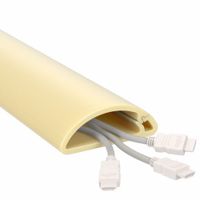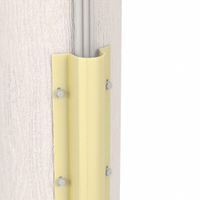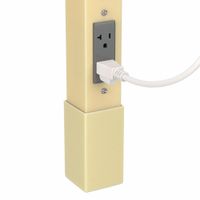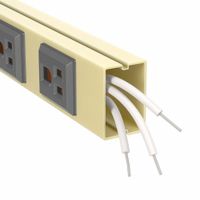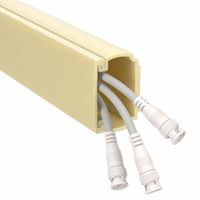Call +(254) 703 030 000 / 751 483 999 / 721 704 777
- Home
- Electrical
- Wire Cable Management
- Surface Raceways Cable Concealers
.....Read More
Frequently Asked Questions
What are surface raceways used for?
Surface raceways are used for organizing, protecting, and concealing electrical wires and cables in residential, commercial, and industrial settings. They provide a neat and efficient way to manage cabling without the need for internal wall modifications, making them ideal for retrofitting or in situations where wall access is limited or undesirable.
Key uses include:
1. **Cable Management**: Surface raceways help in organizing multiple cables, preventing tangling and clutter, which is especially useful in environments with numerous electronic devices.
2. **Aesthetic Improvement**: By concealing wires, raceways enhance the visual appeal of a space, offering a cleaner and more professional look.
3. **Safety**: They protect cables from physical damage, reducing the risk of electrical hazards such as short circuits or fires. This is crucial in high-traffic areas where cables might otherwise be exposed to wear and tear.
4. **Flexibility and Accessibility**: Surface raceways allow for easy access to cables for maintenance, upgrades, or reconfiguration, without the need for extensive construction work.
5. **Compliance**: They help in meeting building codes and safety regulations by ensuring that cables are properly enclosed and protected.
6. **Versatility**: Available in various sizes, shapes, and materials, surface raceways can accommodate different types of cables, including power, data, and communication lines.
7. **Ease of Installation**: They can be easily installed on walls, ceilings, or floors using adhesive backing or screws, making them a convenient solution for both temporary and permanent installations.
Overall, surface raceways offer a practical solution for cable management, enhancing both the functionality and appearance of a space while ensuring safety and compliance.
How do you install surface raceways?
To install surface raceways, follow these steps:
1. **Plan the Layout**: Determine the path for the raceway, considering the location of electrical outlets, switches, and any obstacles. Ensure the path is straight and minimizes bends.
2. **Measure and Mark**: Measure the length of the path and mark the wall where the raceway will be installed. Use a level to ensure straight lines.
3. **Cut the Raceway**: Cut the raceway to the required lengths using a hacksaw or a suitable cutting tool. Ensure clean, straight cuts for a neat installation.
4. **Prepare the Surface**: Clean the wall surface where the raceway will be mounted to ensure proper adhesion if using adhesive-backed raceways.
5. **Install the Base**: If the raceway has a base and cover design, start by installing the base. Use screws or adhesive to secure it to the wall. For screw installation, drill pilot holes and use wall anchors if necessary.
6. **Run the Wires**: Lay the electrical wires or cables inside the raceway base. Ensure there is enough slack for connections and avoid sharp bends to prevent damage to the wires.
7. **Install Fittings**: Use appropriate fittings like elbows, tees, and couplings for corners and junctions. Secure them as per the manufacturer's instructions.
8. **Attach the Cover**: Snap or slide the raceway cover over the base, ensuring it is securely fastened and all wires are concealed.
9. **Secure the Ends**: Use end caps to close off the ends of the raceway, providing a finished look and protecting the wires.
10. **Test the Installation**: Once installed, test the electrical connections to ensure everything is functioning correctly.
11. **Final Inspection**: Check the entire installation for any loose fittings or exposed wires and make necessary adjustments.
What materials are surface raceways made from?
Surface raceways are typically made from a variety of materials, each chosen for specific properties that suit different applications. Common materials include:
1. **PVC (Polyvinyl Chloride):** PVC is widely used due to its affordability, ease of installation, and good insulating properties. It is lightweight, resistant to moisture and chemicals, and provides adequate protection for electrical wiring in residential and commercial settings.
2. **Metal (Aluminum or Steel):** Metal raceways, often made from aluminum or steel, offer superior strength and durability. They are ideal for environments where mechanical protection is crucial, such as industrial settings. Metal raceways also provide excellent electromagnetic interference (EMI) shielding.
3. **Fiberglass:** Fiberglass raceways are used in environments where corrosion resistance is essential. They are non-conductive, making them suitable for applications where electrical insulation is critical. Fiberglass is also lightweight and can withstand harsh environmental conditions.
4. **ABS (Acrylonitrile Butadiene Styrene):** ABS is a thermoplastic known for its toughness and impact resistance. It is used in raceways where flexibility and durability are required. ABS is also resistant to various chemicals and can withstand moderate temperatures.
5. **Polycarbonate:** This material is used for its high impact resistance and clarity. Polycarbonate raceways are often used in applications where visibility of the contents is necessary, such as in data centers or telecommunications.
6. **Composite Materials:** Some raceways are made from composite materials that combine the properties of different substances to achieve specific performance characteristics, such as enhanced strength, flexibility, or thermal resistance.
Each material offers distinct advantages, and the choice depends on factors like the environment, the level of protection required, and cost considerations.
Can surface raceways be painted to match walls?
Yes, surface raceways can be painted to match walls. Surface raceways, often used to conceal and protect electrical wiring, are typically made from materials like PVC or metal. These materials can be painted to blend seamlessly with the surrounding wall color, enhancing the aesthetic appeal of a room.
Before painting, it's important to prepare the raceway surface properly. Start by cleaning the raceway to remove any dust, grease, or debris. This ensures that the paint adheres well. For PVC raceways, lightly sanding the surface can help the paint stick better. Use a fine-grit sandpaper to avoid damaging the material.
Next, apply a primer suitable for the raceway material. For PVC, a plastic primer is recommended, while metal raceways may require a metal primer. Priming is crucial as it provides a base for the paint to adhere to and can improve the durability of the finish.
Once the primer is dry, choose a paint that matches the wall color. Acrylic latex paint is often recommended for its durability and ease of use. Apply the paint using a brush or roller, ensuring even coverage. Multiple coats may be necessary for a uniform finish, allowing each coat to dry completely before applying the next.
Finally, consider using a clear sealant to protect the painted surface from scratches and wear. This step is optional but can extend the life of the paint job.
By following these steps, surface raceways can be effectively painted to match walls, providing a cohesive and polished look to any space.
What is the difference between single-channel and multichannel raceways?
Single-channel raceways are conduits designed to house and protect a single set of cables or wires. They are typically used in environments where the wiring needs are straightforward and minimal, such as in residential settings or small office spaces. These raceways are simpler in design, easier to install, and generally more cost-effective for basic applications. They provide a clean and organized way to manage cables, reducing clutter and potential hazards.
Multichannel raceways, on the other hand, are designed to accommodate multiple sets of cables or wires within a single conduit. They are often used in more complex environments, such as commercial buildings, data centers, or industrial settings, where there is a need to separate different types of cables, such as power, data, and communication lines, to prevent interference and ensure safety. Multichannel raceways offer greater flexibility and organization, allowing for easier upgrades and maintenance. They can be more complex to install and may require more planning and investment upfront, but they provide a scalable solution for environments with evolving wiring needs.
In summary, the primary difference lies in their capacity and application: single-channel raceways are suited for simpler, smaller-scale wiring needs, while multichannel raceways are designed for more complex, larger-scale environments requiring separation and organization of multiple cable types.
How do you choose the right size of surface raceway?
To choose the right size of surface raceway, follow these steps:
1. **Identify Cable Types and Quantities**: Determine the types and quantities of cables you need to accommodate. This includes power, data, and communication cables.
2. **Calculate Cable Fill Capacity**: Use the National Electrical Code (NEC) or relevant local standards to calculate the fill capacity. This involves understanding the cross-sectional area of each cable type and ensuring the total does not exceed the raceway's capacity.
3. **Consider Future Expansion**: Plan for future needs by selecting a raceway with additional capacity. This avoids the need for replacement or additional installations later.
4. **Check Manufacturer Specifications**: Review the specifications provided by raceway manufacturers. They often provide guidelines on maximum cable fill and recommended sizes for different applications.
5. **Evaluate Physical Constraints**: Consider the physical space where the raceway will be installed. Ensure the chosen size fits within the available space and can be mounted securely.
6. **Aesthetic and Functional Requirements**: Choose a raceway that meets aesthetic preferences and functional requirements, such as color, material, and accessibility for maintenance.
7. **Compliance with Codes and Standards**: Ensure the raceway size and installation comply with local building codes and industry standards to ensure safety and reliability.
8. **Consult with Professionals**: If unsure, consult with electrical engineers or professionals who can provide expert advice based on specific project needs.
By considering these factors, you can select a surface raceway that effectively meets current and future requirements while ensuring compliance and functionality.
Are surface raceways suitable for outdoor use?
Surface raceways are generally not suitable for outdoor use. They are primarily designed for indoor applications to manage and conceal electrical wiring along walls, floors, or ceilings. The materials used in standard surface raceways, such as PVC or plastic, are typically not rated for exposure to outdoor elements like UV radiation, moisture, temperature fluctuations, and physical impacts, which can lead to degradation, warping, or cracking over time.
For outdoor applications, it is crucial to use raceways specifically designed and rated for exterior environments. These outdoor raceways are made from materials that can withstand harsh weather conditions and are often UV-resistant, waterproof, and more robust to prevent damage from environmental factors. They may also have additional features like gaskets or seals to protect the wiring from moisture ingress.
When planning to use raceways outdoors, it is essential to check the product specifications and ensure they comply with relevant electrical codes and standards, such as the National Electrical Code (NEC) in the United States, which provides guidelines for the safe installation of electrical wiring and equipment. Using the correct type of raceway ensures safety, longevity, and compliance with legal requirements.
In summary, while standard surface raceways are not suitable for outdoor use, there are specialized outdoor raceways available that are designed to handle the challenges of exterior environments. Always ensure that the chosen raceway is rated for outdoor use and complies with applicable codes and standards.
